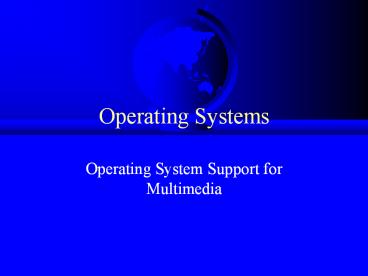Operating Systems - PowerPoint PPT Presentation
Title:
Operating Systems
Description:
Title: Operating System Support for Multimedia: QLinux Author: Claypool Last modified by: Instructional Media Center Created Date: 6/10/1995 5:31:50 PM – PowerPoint PPT presentation
Number of Views:27
Avg rating:3.0/5.0
Title: Operating Systems
1
Operating Systems
- Operating System Support for Multimedia
2
Why Study Multimedia?
- Improvements
- Telecommunications
- Environments
- Communication
- Fun
- Outgrowth from industry
- telecommunications
- consumer electronics
- television
3
Continuous Media
- Subset of multimedia
- Includes timing relationship between server and
client - Stream
- video mpeg, H.261, avi, QuickTime, MediaPlayer
- audio MP3, µ-law
4
Multimedia Resource Requirements
- Step up in media requires more bytes
- But not as much as some applications!
- Graphics or transaction processing
5
Influences on Quality
S0
S2
S1
S3
S4
Server
t0
Client
t0
C0
C1
C2
C3
Data Loss
Delay
Jitter
6
An End-To-End Problem
--- 160 148 190 ...
160 160 160 160 ...
Server
Client
- Server Application
- Operating System
- Network Protocol
- Client Application
- Operating System
- Network Protocol
Network Routers
7
Application Performance in the QLinux Multimedia
Operating System
Sundaram, A. Chandra, P. Goyal, P. Shenoy, J.
Sahni and H. Vin UMass Amherst, U of Texas Austin
In Proceedings of ACM Multimedia
Conference November 2000
8
Introduction
- General purpose operating systems handling
diverse set of tasks - Conventional best-effort with low response time
- Ex word processor
- Throughput intensive applications
- Ex compilation
- Soft real-time applications
- Ex streaming media
- Many studies show can do one at a time, but when
do two or more grossly inadequate - MPEG-2 when compiling has a lot of jitter
9
Introduction
- Reason? Lack of service differentiation
- Provide best-effort to all
- Special-purpose operating systems are similarly
inadequate for other mixes - Need OS that
- Multiplexes resources in a predictable manner
- Service differentiation to meet individual
application requirements
10
Solution QLinux
- Solution QLinux (the Q is for Quality)
- Enhance standard Linux
- Hierarchical schedulers
- classes of applications or individual
applications - CPU, Network, Disk
11
Outline
- QLinux philosophy
- CPU Scheduler
- Evaluation
- List of other topics in paper
- Packet Scheduler
- Disk Scheduler
- Lazy Receiver Processing
- Conclusion
12
QLinux Design Principles
- Support for Multiple Service Classes
- Interactive, Throughput-Intensive, Soft Real-time
- Predictable Resource Allocation
- Priority not enough (starvation of others)
- Ex mpeg_decoder at highest can starve kernel
- Not static partitioning since unused can be used
by others
13
QLinux Design Principles
- Service Differentiation
- Within a class, applications treated differently
- Uses hierarchical schedulers
- Support for Legacy Applications
- Support binaries of all existing applications (no
special system calls required) - No worse performance (but may be better)
14
QLinux Components
15
Hierarchical Start-time Fair Queuing(H-SFQ) CPU
Scheduler
(Typical OS?)
- Uses a tree
- Each thread belongs to 1 leaf
- Each leaf is an application class
- Weights are of parent class
- Each node has own scheduler
- Uses Start-Time Fair Queuing at top for time for
each
16
CPU Scheduler System Calls
- Nodes can be created on the fly
- Processes can move from node to node
- Defaults to top-level fair scheduler if not
specified - Utilities to do external from application
- ? Allow support of legacy apps without modifying
source
17
Experimental Setup
- Cluster of PCs
- P2-350 MHz
- 64 MB RAM
- RedHat 6.1
- QLinux based on Linux 2.2.0
- Network
- 100 Mb/s 3-Com Ethernet
- 3Com Superstack II switch (100 Mb/s)
- Assume machines and net lightly loaded
18
Experimental Workloads
- Inf executes infinite loop
- Compute-intensive, Best effort
- Mpeg_play Berkeley MPEG-1 decoder
- Compute-intensive, Soft real-time
- Apache Web Server and Client
- I/O intensive, Best effort
- Streaming media server
- I/O intensive, Soft real-time
- Dhrystone measure CPU performance
- Compute-instensive, Best effort
19
CPU Scheduler Evaluation-1
- Two classes, run Inf for each
- Assign weights to each (ex 11, 12, 14)
- Count the number of loops
20
CPU Scheduler Evaluation-1 Results
count is proportional to CPU bandwidth allocated
21
CPU Scheduler Evaluation-2
- Two classes, equal weights (11)
- Run two Inf
- Suspend one at t250 seconds
- Restart at t330 seconds
- Note count
22
CPU Scheduler Evaluation-2 Results
(Counts twice as fast when other suspended)
23
CPU Scheduler Evaluation-3
- Two classes soft real-time best effort (11)
- Run
- MPEG_PLAY in real-time (1.49 Mbps)
- Dhrystone in best effort
- Increase Dhrystones from 1 to 2 to 3
- Note MPEG bandwidth
- Re-run experiment with Vanilla Linux
24
CPU Scheduler Evaluation-3 Results
25
CPU Scheduler Evaluation-4
- Explore another best-effort case
- Run two Web servers (representing, say 2
different domains) - Have clients generate many requests
- See if CPU bandwidth allocation is proportional
26
CPU Scheduler Evaluation-4 Results
27
CPU Scheduler Overhead Evaluation
- Scheduler takes some overhead since recursively
called - Run Inf at increasing depth in scheduler
hierarchy tree - Record count for 300 seconds
28
CPU Scheduler Overhead Evaluation Results
29
QLinux Components
- Disk
- Not evaluated
- Packets
- - Sending and Lazy Processing for Receiving
30
Conclusion
- Some improvement and some ideas
- Still Much work to be done
- scheduling
- memory management
- network
- disk
- M.S. Thesis
- One piece in OS support puzzle































